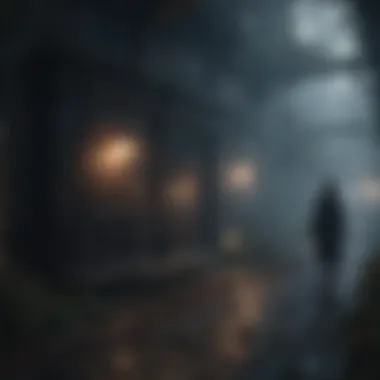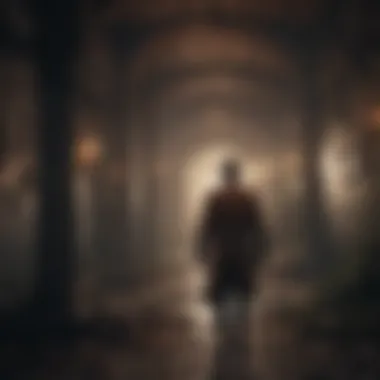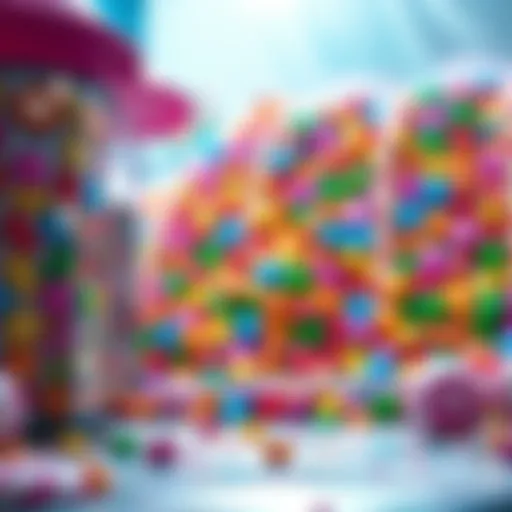The Evolution of Horror Games on Apple Arcade


Intro
Horror games often walk the thin line between fascination and fear, drawing players into a world where every shadow might be hiding a terrifying surprise. With the rise of mobile technology, platforms like Apple Arcade have carved out a niche for these adrenaline-pumping experiences. The goal here is to embark on a journey through the unique creative offerings of horror games on Apple Arcade, paying close attention to what makes them stand out in a crowded genre.
While traditional consoles may have set the stage for horror gaming, mobile platforms are now cultivating immersive storytelling and innovative gameplay mechanics. Apple's curated selection blends high-quality graphics, intricate narratives, and user-friendly controls to enhance the horror experience. This exploration aims to peel back the layers of horror gaming on Apple Arcade, looking at how it has evolved and what players can expect from this new age of mobile terror.
Whether you're a seasoned horror gamer or simply curious about the genre, there’s something eerie and unsettling waiting just around the corner of your device's screen. Prepare yourself for a dive into chilling atmospheres and gripping plots, and get ready to uncover the standout titles and thrilling gameplay that Apple Arcade has to offer.
Prelims to Horror Gaming on Mobile
The mobile gaming landscape has undergone a seismic shift in recent years, with horror games capturing the imagination of a broad spectrum of players. This section aims to uncover the significance of horror gaming on mobile platforms, spotlighting its unique qualities that facilitate immersive experiences in a portable format. The connection between technology and the horror genre is not just an afterthought but a critical component that binds the two worlds together.
The emergence of horror games on mobile devices has opened doors to creativity, allowing developers to craft chilling atmospheres and narratives that challenge the players’ nerves. In a realm where accessibility meets unsettling themes, these games offer not just entertainment but also a space to confront fears in a controlled environment.
The Rise of Mobile Horror Games
The ascent of mobile horror games can be traced back to several factors. First, the advancements in mobile technology have made it possible for developers to create rich, dynamic environments that engage players on multiple levels. Games can now utilize high-quality graphics, realistic soundscapes, and immersive storytelling, all from the palms of our hands. Increasing access to smartphones has made horror gaming available to anyone with a device, breaking down the barriers that once confined the genre to consoles and PCs.
Moreover, the rise of indie developers has injected fresh blood into the horror gaming scene. Many of these studios are eager to push the envelope and explore unconventional narrative arcs and gameplay mechanics. Titles like The Walking Dead: Season One have shown that gripping storytelling can thrive in bite-sized pieces, making horror more digestible and accessible for players.
The interplay between social networks and horror gaming has also played a part in its rise. Players are more inclined to share their gameplay experiences, fostering a community that thrives on the thrill of experiencing fear together. Whether it’s an unsettling jump scare or a tense moment, these shared experiences elevate the genre, turning individual playtime into a communal event.
Understanding the Appeal of Horror
Why do we choose to be scared in our leisure time? This question is at the heart of understanding the appeal of horror games. The genre grants players the ability to explore their fears in anticipation of a thrill, rather than facing real danger. In a safe environment, individuals can confront what frightens them, leading to a cathartic release when they emerge back into the real world.
Additionally, horror games often engage players on a psychological level. The journey of dealing with the unknown is compelling and addictive. Elements like suspenseful music, unexpected twists, and atmospheric storytelling keep players on the edge of their seats.
Another layer of this appeal is the social interaction that horror gaming often engenders. Players often share their heart-racing moments in forums or social media, enhancing the collective experience. The thrill of fear mingled with community camaraderie creates an atmosphere that attracts a diverse audience, from seasoned gamers to those casually dabbing their toes in nightmarish waters.
Apple Arcade: A New Frontier for Games
The realm of digital gaming is constantly evolving, with emerging platforms reshaping how players experience titles across genres. Apple Arcade is one such frontier, offering a curated subscription service that focuses on quality and diversity in gameplay. This innovative approach allows Apple to carve out a niche in the gaming industry, particularly by hosting compelling horror titles that appeal to gamers who crave thrills on the go.
The significance of Apple Arcade in the horror gaming landscape cannot be understated. First, it provides a platform that allows developers to create unique and immersive horror experiences without the burden of in-game advertisements or microtransactions, which often distract from the narrative. This means that creators can take artistic risks and develop richer stories that truly captivate the player’s imagination. Furthermore, with a subscription model, players can explore various titles, broadening their exposure to the spectrum of horror gaming available.
Overview of Apple Arcade
Launched in September 2019, Apple Arcade marked a bold transition for mobile gaming. By offering a monthly subscription that grants access to over a hundred games, the platform emphasizes accessibility and variety. Players can delve into a treasure trove of exclusive games, which cater to numerous interests, including the chilling corridors of horror.
Apple Arcade appeals not only to casual gamers but also to those seeking deeper gameplay. The games can be played across different Apple devices, thus ensuring seamless transition whether one is playing on a iPhone, iPad, or Mac. This greater accessibility invites gamers to immerse themselves in the eerie atmosphere of horror titles without the usual caveats that come with purchases in the typical mobile gaming oeuvre.
For example, titles like 'Tainted Grail: Conquest' integrate lore and psychological depth, which are enhanced through immersive storytelling strategies that Apple Arcade supports. The subscription nature means players aren’t pigeonholed into a limited selection but can freely jump from one spine-tingling experience to another without concerns about paying for each individual game, which might otherwise discourage exploration.
Subscription Model and Economic Impact


The subscription model adopted by Apple Arcade has significant ramifications for the gaming landscape. It enables developers to receive a stable revenue stream, reducing financial stress linked to what can often be an unpredictable market. As a result, there’s an increased incentive for them to create original content, particularly in niche genres like horror, that might not otherwise get the attention it deserves.
Moreover, from the consumer standpoint, this model lowers the financial barrier to entry for gamers. Here are some important aspects to consider:
- Cost Efficiency: Instead of paying upwards of $60 for a single game, players can experience a wide array of offerings for a flat fee. This invites experimentation with lesser-known horror titles, potentially leading to hidden gems.
- Curated Quality: Unlike many free games that flood the market with mediocre titles, Apple Arcade’s selection process means that each game holds a certain standard of quality.
- Encouraging Innovation: Developers are challenged to innovate, creating experiences that push boundaries in a genre known for its predictability.
In short, the economic model of Apple Arcade is tailor-made to foster creativity and allow players to engage more profoundly with games. The horror genre on this platform stands to benefit from this by attracting creators who are ready to explore unknown territories, thus reshaping how we perceive mobile horror gaming.
Genres within Horror Gaming
Horror gaming is a vast and intricate landscape, full of diverse genres that cater to a wide array of player experiences. Each genre brings its own unique flavor to the table, transforming the act of playing games into an emotional rollercoaster. Understanding genres within horror gaming is not just an academic exercise but a window into what makes these games chilling and engaging. Players are drawn to certain types of horror for various reasons—some might crave psychological depth while others seek pure survival tension. Each genre offers distinct benefits that heighten the overall gaming experience, making it vital to explore their unique offerings.
Psychological Horror: A Deep Dive
Psychological horror shifts the focus from jump scares to the mind's dark corners. Games in this genre often play with the player’s perceptions and emotions, inducing a feeling of dread rather than relying on cheap thrills. Titles like What Remains of Edith Finch or Layers of Fear exemplify this approach. They tug at players' heartstrings while also making them question their sanity alongside the protagonists.
The beauty of psychological horror lies in its ability to evoke feelings of unsettlement, anger, and fear through narrative choices and atmospheric elements. Engaging sound design and visual oddities enhance the experience, making players second guess what's real. This deep dive into mental anguish forces players to confront their fears relational rather than immediate. In many instances, the game mechanics support the narrative complexity, transforming players into active participants in unsettling plots instead of mere spectators.
Survival Horror: Tension and Strategy
Survival horror thrives on the tension of limited resources and the constant threat of annihilation. Think Resident Evil or Amnesia: The Dark Descent. It’s about survival against all odds—scavenging for weapons, managing limited health supplies, and attempting to outsmart the lurking terror. The high-stakes nature fosters a genuine sense of urgency, keeping players on edge.
Unlike psychological horror, which is more introspective, survival horror compels players to strategize. Do you use that last health kit now or save it for a tougher fight later? This genre incorporates a calculation aspect that adds to the excitement while enhancing player immersion. The interaction between strategy and gameplay becomes a hallmark here, driving home the adrenaline as players find themselves on the edge of their seats, making critical decisions that could lead to their virtual demise.
Retro Horror: Nostalgia Meets Fear
Retro horror marries classic gaming aesthetics with chilling narratives, often invoking feelings of nostalgia while simultaneously unsettling players. Picture haunting pixel art visuals combined with nostalgia-tinged soundtracks reminiscent of the early gaming era. Games like Uninvited and 101 Ways to Die tap into a unique vein that resonates with seasoned gamers who have faced the challenges of gaming in a bygone era.
Retro horror’s charm lies in its simplicity and the evocative feelings it conjures. By embracing older graphics and sound styles, it invites players to delve into pixelated nightmares that are as much about what you can’t see as what’s plainly visible. Given that recognition of the past feeds into the horror, players often find themselves drawn into the narrative, engaged by not just the scares but the memories those designs evoke. Perhaps a dimly lit pixelated environment reminds them of the lonely hours in front of an 8-bit screen, amplifying their fear just as much as the jump scares do.
The diversity in horror genres offers more than mere mutations of fear—they draw on distinct emotional and conceptual wells from which to immerse players.
In summary, horror gaming's classification into various genres provides players with a smorgasbord of experiences. From psychological depth to the thrill of survival and the warm glow of retro graphics, each genre plays a critical part in how horror can be approached and appreciated.
Notable Horror Titles on Apple Arcade
In the realm of mobile gaming, horror titles on Apple Arcade represent a unique niche that captures players’ imaginations and takes them deep into thrilling narratives. These games are not only about scaring players but also engaging them on a psychological level, often intertwining complex characters and unique stories that linger long after gameplay. Whether players are seeking to unearth unsettling mysteries or face their fears head-on, the standout offerings on Apple Arcade provide both a palpable sense of dread and a rich tapestry of experiences.
Reviewing 'Grim Fandango Remastered'
'Grim Fandango Remastered' is a classic that deserves a spotlight in the discussion of horror on mobile platforms. Set in the Land of the Dead, players follow Manny Calavera, a travel agent for deceased souls. The visuals possess a haunting beauty, mixing dark humor with poignant storytelling. This adventure game deftly balances its eerie setting with clever puzzles and memorable characters.
While not outright terrifying, its atmosphere employs shades of horror through the peculiar environment and nuanced character interactions. The remastering brings improved graphics and audio, enhancing the eerie charm of the journey. Players experience a mix of nostalgia and fresh intrigue, propelling them through the brilliantly crafted narrative that keeps you eager to unearth every layered mystery.
Exploring 'The Last Campfire'


Another notable title is 'The Last Campfire', which offers a different take on horror through an emotional and introspective lens. The game presents a world filled with lost souls, fraught with the essence of fear and despair. Players embark on a quest in search of hope, encountering various challenges that elicit both tension and compassion.
The art style, simple yet evocative, captures the essence of loneliness and the unknown. Each interactive moment stringently delights players with its unexpected turns. Sound design plays a crucial role in setting the mood; the whispers of the campfire, the winds that howl, and the subtle ambient layers create an immersive auditory experience. This game highlights that horror can be about emotional journeys and subtle ruminations, urging players to confront both external adversities and internal struggles.
Narrative Elements in 'Demon’s Tournament'
'Demon’s Tournament' stands out with its gripping narrative structure that draws players into the depths of its sinister world. With elements that echo classic horror themes, including betrayal, sacrifice, and redemption, the game immerses participants in a tournament governed by dark supernatural forces. Players find themselves oscillating between moments of trepidation and intense strategic gameplay, which fuels excitement and dread alike.
The story unravels through dialogue and choices, which shape the player's journey. This choice-driven narrative fosters a connection between the player and the characters, emphasizing the impact of decisions made in tense situations. Well-crafted dialogue coupled with an ominous backdrop serves to ensnare players in the web of storytelling, each encounter unfolding layers of horror.
Players must navigate both physical and moral quagmires, drawing them deeper into the compelling blend of horror and strategy that is integral to the game’s appeal.
Gameplay Mechanics in Horror Games
In the realm of horror gaming, the mechanics play a crucial role, serving as the backbone that supports not just gameplay, but the entire atmosphere and player experience. Gameplay mechanics are not merely technical functionalities; they’re the very tools that create the tension and excitement that define the genre. Players don’t just engage with a game; they dive headfirst into a world of dread, where every sound, movement, and decision can mean the difference between survival and doom.
Key elements of gameplay mechanics in horror games include:
- Sound Design: The auditory elements amplify tension, setting the mood and hinting at what lies ahead. The subtle creaks of an old house or distant whispers can send shivers down the spine, guiding player expectations.
- Visual Cues: This includes lighting, colors, and movement types within the game environment. Shadows can enhance fear, while sudden changes in framing or perspective can trigger visceral reactions.
- Interactivity: Players must often make complex decisions when faced with terrifying choices, affecting not just their survival but the game's trajectory.
The effectiveness of these mechanics is influenced by a careful balance of unpredictability and control. If players feel too powerless, fear may tip into frustration. Conversely, if they're given just enough power to confront their fears, it creates a thrilling rollercoaster of emotions. Thus, understanding these gameplay mechanics becomes essential for appreciating how horror games maintain their grip on players.
Creating Atmosphere Through Sound Design
Sound design in horror games is akin to breathing life into the abyss. It shapes the players' experiences and reactions, guiding them through eerie environments. Within the context of Apple Arcade games, sound can elevate the immersive experience.
Consider these aspects of sound design:
- Environmental Sounds: From the howl of wind to the distant growl of a creature, every subtle sound contributes to the feeling of dread. These elements work together to build a soundscape that feels open—yet claustrophobic, fostering an unsettling dichotomy.
- Dynamic Audio Cues: Often, games employ varied sound cues that react to player actions. For instance, footsteps trailing behind may signal danger or a looming entity, pushing players to act or hide.
- Music and Score: The score is instrumental in modifying the emotional tone. A foreboding score can build tension, while sudden crescendos can serve as jump scares, jolting the player out of their comfort zone.
A well-executed soundscape becomes a crucial DNA component of horror gaming that profoundly engages players, placing them in a haunting embrace.
Visual Cues and Player Immersion
Visual cues are decisive in aligning players with the horror experience. These cues effectively manipulate the player's perception and emotional state, guiding them on a thrilling yet terrifying journey.
Important visual elements show how this is achieved:
- Lighting: Shadows and dimly lit corridors can denote danger or hide threats. The use of flickering lights can produce anxiety and uncertainty, as players aren't always sure what lurks in the darkness.
- Color Palette: Grayscale or desaturated colors often signify unease, while vibrant colors can draw attention to significant objects or threats, creating an unsettling contrast.
- Animation and Movement: The way characters or creatures move affects immersion. Abrupt, jerky movements can induce fear, while smooth, steady motions can either create a sense of danger or seem deceptively harmless.
"In horror gaming, it's the unseen that often ignites the imagination; what we can't see can be far more terrifying than what we can."
By focusing on visuals and establishing a coherent connection between what players see and how they feel, developers create a deeper layer of immersion that resonates long after gameplay ends.
User Experience and Interactivity


User experience (UX) and interactivity play crucial roles in immersing players in the haunting worlds of horror games offered on Apple Arcade. Unlike traditional gaming platforms, mobile devices emphasize ease of use and intuitive control schemes, allowing players to navigate spine-chilling atmospheres at their fingertips. The ability to connect, react, and engage directly with the game environment enhances the overall experience, making it vital to analyze how these elements weave together to create a captivating horror narrative.
The Role of Touch and Motion Controls
Touch controls have revolutionized mobile gaming, offering a tactile experience that’s integral to horror games. When you tap, swipe, or tilt your device, you're not just playing; you're participating in a story that unfolds with your every action. For instance, games like Oxenfree incorporate swiping and button mashing to enhance tension, inviting players to respond quickly to sudden scares. The immediacy of touch controls adds an extra layer of fear and excitement—players can hardly predict what lies ahead.
Motion controls serve as another layer of interaction. Imagine your phone vibrating as a ghostly entity approaches, or tilting your device just right to uncover hidden secrets. This physical engagement creates a sense of presence and urgency that’s often missing in static play. The fear in these moments isn’t just in the game’s audio or visuals; it’s felt through your body as well.
Adjusting Difficulty and Accessibility
The nature of horror gaming often hones in on psychological tension, creating environments that challenge even the most seasoned players. However, the ability to adjust difficulty and accessibility is paramount in ensuring that all players can enjoy these chilling experiences. Mobile platforms like Apple Arcade allow developers to fine-tune game settings, accommodating a broader audience.
Considerations for adjusting difficulty include:
- Adaptive Challenges: Some games implement systems that dynamically alter difficulties based on the player's performance, ensuring they remain engaged but not overwhelmed. This means a newbie can navigate the horrors without feeling lost while veterans can face true terror.
- Accessibility Features: Options like colorblind modes, adjustable text sizes, and easy-navigation menus help create an inclusive environment. Games that allow users to modify these settings can attract a diversity of players who may otherwise shy away from horror games.
- Mentorship Elements: Some titles introduce hints or guidance for new players, guiding them through initially daunting encounters. This can alleviate the fear factor while preserving the essence of dread—players must still confront their fears without being thrown into the deep end.
In summary, user experience and interactivity are the backbone of horror gaming on Apple Arcade. The success of these features hinges upon thoughtful design, ensuring that players can fully immerse themselves in frightful narratives while accommodating different skill levels and preferences. As technology evolves, the potential for more nuanced interactivity will only expand, potentially redefining the genre altogether.
The Future of Horror Gaming on Apple Arcade
The landscape of horror gaming, particularly on platforms like Apple Arcade, is poised for remarkable developments. As players continue to seek thrills and chilling narratives, there is a strong belief that the future will be shaped by both technological advancements and evolving player preferences. Diving into this topic highlights why understanding these factors is crucial for the industry, developers, and players alike. The interplay of immersive gameplay, new technologies, and narrative depth will set the stage for horror games that can unsettle and surprise even the most seasoned fans.
Potential Trends to Watch
As we look forward, several trends are beginning to emerge that could redefine the horror gaming experience on Apple Arcade:
- Augmented Reality (AR) Integration: As devices become more sophisticated, the incorporation of AR features could create a new dimension of fear. Imagine wandering through a dark room and having chilling elements overlay the real world—this might be the next big selling point for horror titles.
- Narrative Choices: Players are increasingly looking for games that allow them to carve out their path. Dungeon-like experiences with multiple endings based on player decisions may gain traction. Games that prioritize storytelling through player choices might become more popular.
- Community-Centric Experiences: The horror genre thrives on shared fear. Future titles may incorporate real-time multiplayer elements, allowing friends to tackle terrifying challenges together while sharing their reactions via streaming platforms.
- Cross-Platform Play: As more people own various gaming devices, the demand for interoperability between mobile, console, and PC is likely to grow. This flexibility can enhance engagement and encourage horror game developers to reach wider audiences.
By keeping these trends in mind, developers can craft games that resonate more deeply with players, thereby driving interest in the genre.
Impacts of Technology on Game Development
Technology's role in the evolution of horror games on Apple Arcade cannot be overstated. As we have seen the introduction of more advanced tools for game creation, these innovations offer profound opportunities for creators:
- Improved Graphics and Sound Design: Advancements in graphics technology lead to more realistic textures and environments. Sounds are getting more nuanced. As such, horror games can utilize audio cues that trigger unique emotional responses, leaving players more on edge.
- Artificial Intelligence (AI): AI in horror game design can lead to smarter NPCs that adapt their behavior based on player actions, escalating fear through unpredictability. This aspect can drastically alter gameplay dynamics and challenge player skills in ways previously unexplored.
- Cloud Gaming Technologies: As cloud capabilities grow, developers might consider launching solely on platforms like Apple Arcade to leverage high-quality streaming. This could expand the accessible audience since mobile devices would no longer be bound by hardware limitations.
In summary, as technological landscapes evolve, so too will the creative processes of those crafting horror experiences. Through innovation combined with the inherent appeal of horror themes, the future looks promising for enthusiasts, potentially leading to unforgettable gaming experiences on Apple Arcade.
Closure
The exploration of horror games on Apple Arcade reveals a fascinating intersection between mobile technology and compelling storytelling. With each title steeped in rich narratives and gripping gameplay mechanics, the platform has carved out a niche that appeals to a diverse audience, from casual players to dedicated horror enthusiasts.
Summarizing the Journey of Horror on Apple Arcade
As we trace the path of horror games on Apple Arcade, it becomes clear that these experiences have evolved significantly. From early mobile adaptations, which often felt like mere shadows of their more robust console and PC counterparts, horror gaming on this platform has taken a substantial leap forward. Titles like Grim Fandango Remastered and The Last Campfire illustrate this change, showcasing requirements for deeper engagement. They utilize advanced sound design, intricate visuals, and thoughtful narratives that go beyond jump scares and cliché tropes. Each game also revels in the unique interactivity that touch screens offer. Players aren't just observers; they're part of the unfolding dread and triumph.
This journey doesn't just highlight technological advancements; it speaks volumes about how mobile gaming platforms can provide immersive and meaningful experiences. The meticulous crafting of atmosphere and tension blends beautifully with the ease of access that a mobile device provides—players can freely roam through eerie worlds without needing to be tethered to a console.
Final Thoughts on Gaming Evolution
Thus, observing the evolution of horror games on Apple Arcade, there’s an underlying truth that resonates: the genre is not stagnant. It’s ever-changing. Developers are continuously pushing boundaries, exploring themes of fear, isolation, and uncertainty. These narratives challenge players not merely to survive but to think, feel, and confront emotions often left unspoken.
In closing, horror gaming remains a vital part of the larger gaming ecosystem. The evolution taking place within the realms of Apple Arcade signifies that this platform is not just about casual play; it has the potential to deliver deep, resonant experiences that both entertain and provoke thought. It's a noteworthy consideration for anyone tracking gaming trends. Those looking to explore this genre on mobile have a treasure trove waiting at their fingertips, with each title promising more than just thrills—offering an invitation to ponder what scares us most in a rapidly changing world.





